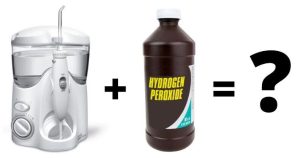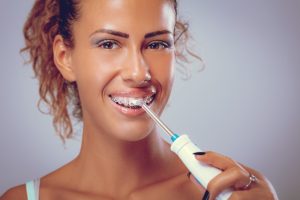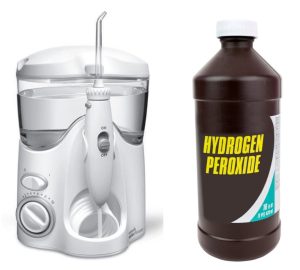Are you wondering if you can put hydrogen peroxide in your Waterpik? And if so, how much?
Hydrogen peroxide is a vital ingredient in teeth whitening so you may be wondering whether you can use it in your Waterpik water flosser to clean your gums.
But, first of all, what is hydrogen peroxide?
Hydrogen peroxide is a mild disinfectant that is often used on the skin to prevent infection from small wounds, burns, and scrapes. It can also be used to get rid of mucus and treat mild lip irritation as a mouthwash.
It releases oxygen whenever it is applied to the afflicted region. The bubbling is induced by the release of oxygen, which helps to peel away the top layer of skin and disinfect the surface. Serious wounds, animal bites, and severe burns should not be treated with hydrogen peroxide.
Our goal with this article is to answer all the questions you may have about using hydrogen peroxide in Waterpik water flossers.
In This Article
Can I put hydrogen peroxide in my Waterpik?

The answer is yes. Hydrogen peroxide rinses with low concentrations are completely safe and you can use them in your Waterpik, but make sure to check the instructions on your particular device first.
How much hydrogen peroxide should I put in my Waterpik?
You probably have some questions about how much peroxide to use in your Waterpik. Well, to remove debris and bacteria from your teeth and gums, use a diluted 3 percent hydrogen peroxide solution.
To use the Waterpik, fill half the tank with lukewarm water, then fill the other half of the tank with 3 percent hydrogen peroxide. Close the tank lid and make sure it’s locked. Then, turn on the device and direct the tip toward your teeth. Rinse your gums between each tooth for about five seconds with a 1:1 solution of 3 percent hydrogen peroxide and water.
What are the benefits?
One of the key advantages of using hydrogen peroxide in a Waterpik is that it can get to those hard-to-reach areas. Health benefits may include gingivitis prevention and treatment, and teeth whitening.
Some models of Waterpik have a periodontal pocket tip which can make the device even more efficient at reaching different areas around the mouth. This is especially good for those looking for Waterpik solutions for periodontal disease, or even tonsil stones.
Some of the other advantages are:
Gingivitis treatment
If you have sensitive gums that bleed and are often inflamed or red (indicators of gingivitis), hydrogen peroxide may be an effective therapy choice. The results of this study found that hydrogen peroxide made participants’ gums healthier and reduced amounts of the pathogen porphyromonas gingivalis, which causes gingivitis.
Gingivitis is treated by rinsing the gums with a liquid that destroys the germs that cause the condition on a regular basis. Using hydrogen peroxide in a Waterpik can be helpful in this situation.
Helps relieve a sore throat

A sore throat may be treated by using hydrogen peroxide in a Waterpik. One of the causes of sore throat is a fungus infection. Rinsing with hydrogen peroxide may help to alleviate the symptoms while also reducing the irritation produced by the germs.
It can prevent gingivitis
The antibacterial properties of hydrogen peroxide in your Waterpik can help to prevent gum disease and improve your oral hygiene. Hydrogen peroxide creates oxygen, which destroys bacteria that create plaque — a sticky covering that forms on the surface of your teeth — when gargled or used in a Waterpik.
Treatment of mouth ulcers
Using hydrogen peroxide in your Waterpik can also help if you suffer from mouth ulcers. Hydrogen peroxide aids in the killing of bacteria, cleaning surfaces, and the removal of dead tissue. It’s possible that this method may accelerate the healing of a mouth ulcer or minor scrape.
Teeth Whitening
Many kinds of toothpaste and mouthwashes that are meant to whiten teeth include hydrogen peroxide as an ingredient. Using hydrogen peroxide in your Waterpik could also help with teeth whitening.
Although using hydrogen peroxide to whiten teeth is helpful, there are many more effective ways to do so, such as carbamide peroxide. If teeth whitening is the main reason you want to put hydrogen peroxide in a Waterpik, then you might want to check out this article about teeth whitening with hydrogen peroxide.
Are there any risks?
Yes, there are potential risks associated with using hydrogen peroxide in a Waterpik. Aside from having a terrible aftertaste, it can also be hazardous when used in the wrong way.
- Harmful when consumed: Too much hydrogen peroxide in the stomach may produce major adverse effects such as stomach burning, nausea, and vomiting.
- Weakened enamel: If used for too long, too frequently, or in too high doses, hydrogen peroxide may harm tooth enamel.
- Temporary oral irritation: It may also cause oral irritation, with symptoms that might continue for many hours.
- Dry mouth: Peroxide may make your mouth dry, which is harmful to your oral health. Saliva is necessary for the removal of bacteria from your mouth as well as the remineralisation of tooth enamel.
- Black hairy tongue: This is a fairly innocuous and temporary oral issue that seems to be much worse than it is! It may happen if you use mouthwashes that include oxidising agents like peroxide.
Hydrogen peroxide should only be used when diluted with water!
Keep the following in mind when using hydrogen peroxide in a Waterpik

Using hydrogen peroxide in Waterpik water flossers has benefits and potential risks. Keep the following in mind:
- Before using hydrogen peroxide as a mouthwash or adding it to your Waterpik, make sure you dilute it appropriately with water.
- Limit daily usage to 1-2 weeks at first, then 3 days per week after that.
- Long-term usage of hydrogen peroxide raises the risk of salivary free radical production, which is linked to precancerous tissue alterations.
- Furthermore, you should stop using diluted hydrogen peroxide if it causes burning or swollen gums.
You should always consult a doctor before starting a new oral hygiene routine.
Conclusion
Using hydrogen peroxide in a Waterpik is a more advanced method of cleaning between and around your teeth.
If you’re looking to cure a particular oral condition or just want to enhance your general dental health, hydrogen peroxide may be an excellent option. However, consult your dentist before adopting it into your daily regimen and make sure to consult a doctor for a diagnosis.
It’s worth repeating that hydrogen peroxide should only be used after being diluted with water.
Depending on what you are trying to achieve, you might also want to use hydrogen peroxide as a mouthwash, aside from using it in a Waterpik or other water flosser.
If your main reason for using hydrogen peroxide in a Waterpik is to whiten your teeth, it’s worth checking out some other more effective alternatives.




